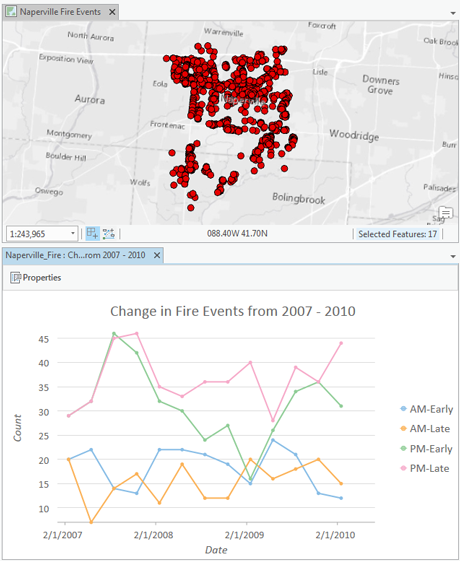Line charts visualize change over a continuous range, such as time or distance. Visualizing change with a line chart allows for the overall trend to be displayed at once and for multiple trends to be compared simultaneously.
Variables
Line charts are composed of a continuous date or number on the x-axis, and an associated numeric value on the y-axis.
The x-axis of a line chart displays a continuous variable such as time or distance, and a line is drawn visualizing the change in value between each consecutive time or distance interval. Each interval is marked with a point corresponding to a numeric value measured by the y-axis.
When a number field is chosen for the x-axis and each number appears in the table only once, no aggregation is necessary, but a numeric field must be specified.
When a date field is chosen for the x-axis, the dates are binned, or aggregated, into time intervals. When a line chart is drawn using a date field or an aggregated number field, an Aggregation method must be chosen to specify how the data will be summarized.
If no numeric fields are specified, the chart will use the Count aggregation method, which totals the number of records that appear at each time or distance interval. For example, in a dataset of crime incidents, a date field is binned into two-week intervals with the Count aggregation method. The resulting chart will display a marker for every two-week interval representing how many crimes took place during those two weeks.
If numeric fields are specified, the aggregation method can be one of the following:
- Sum
- Mean
- Median
- Minimum
- Maximum
Lines can be smoothed by checking the Smooth line check box, which applies interpolation to each line in the chart.
Time binning options
Time aggregation, or binning, occurs automatically when a date field is chosen for the x-axis. The options described in the subsections below control the interval size and related settings applied to the binning.
Interval size
Temporal data is binned into time intervals along the x-axis. The default interval size is based on the temporal extent of the dataset and can be manually changed using the Interval size option.
Empty bins
Depending on the sparsity of the dataset and the time interval size chosen for binning, there may be bins that contain no data. Empty bins may be treated as zero when a lack of data truly represents a value of zero (for example, no illnesses were reported in May or no rain was collected during a week span). It is not appropriate to assign a zero value to a bin in which no data exists because none was collected (for example, no reading from a temperature gauge does not mean there was a temperature of zero).
The following are the options for handling empty bins:
- Treat them as zero (Treat as zero)—This is most appropriate when counting incidents, as no incidents counted likely means zero incidents took place.
- Interpolate neighboring values (Connect line)—Null values can be visually interpolated by connecting the line between the bins on either side of the empty bin.
- Break the line (Break line)—Leaves a blank space where an empty bin falls.
Interval alignment
Time intervals can align to the first data point, the last data point, or a specific reference time.
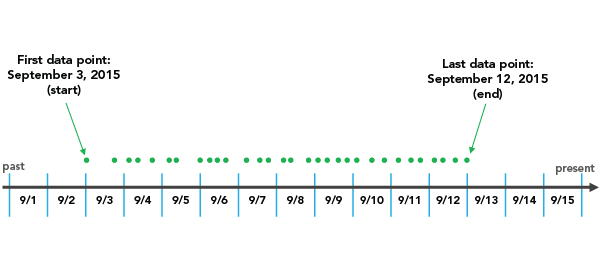
The Snap to first data point option initiates binning with the earliest date and works forward.
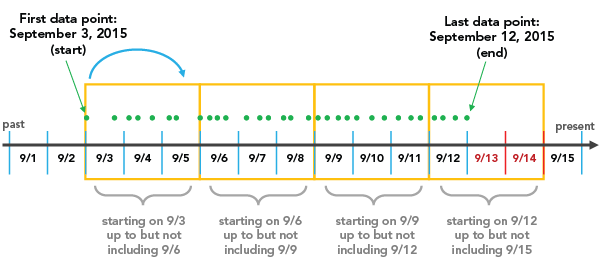
The Snap to last data point option initiates binning with the most recent date and works backward.
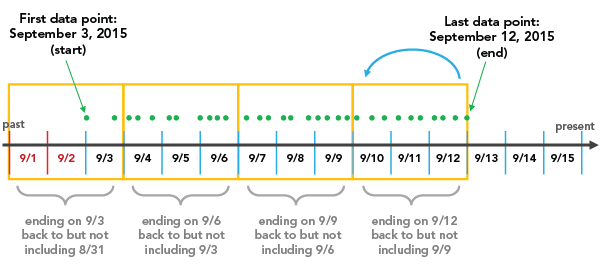
The Reference time option initiates binning at a specific, user-defined date.
Interval alignment is important to consider because, depending on the configuration, partially empty bins may be created. Partially empty bins can give the misleading impression that there is a dip in the value or count during that time, when really the data collection began or ended during the span of that bin. To avoid bin bias, check the Trim incomplete interval option. This removes the partially filled bin from the visualization.
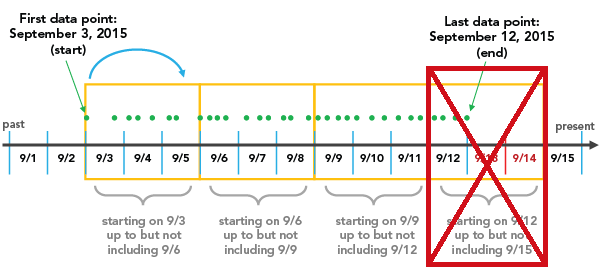
Moving average
If you are using a date field to create a line chart, you can add a moving average. Analysis of temporal data can be problematic due to inconsistent or unreliable data collection. In these cases, it can be helpful to apply a moving average to smooth the noise and obtain a clearer picture of the overall trend. When you check the Show moving average check box, a line is overlaid on the chart that represents the average value of the previous n periods, specified in the Moving average period control.
Note:
Moving average is only available for single-series temporal line charts.
Multiple series
Multiple lines, or series, can be visualized in the same chart to compare trends.
You can create multiple series line charts by adding multiple numeric fields or by setting a Split by category field.
When multiple numeric fields are added, one line is drawn to visualize the change for each numeric field. For example, in a dataset of crime incidents, a date field is binned into two-week intervals with the Sum aggregation method and two numeric fields, PropertyLoss and TotalDamage. The resulting chart will display two lines, one representing the sum of PropertyLoss and the other the sum of TotalDamage for every two-week interval.
You can also use a category field to split a line chart into multiple series. For example, in a dataset of crime incidents, a date field is binned into two-week intervals with the Count aggregation method and the CrimeType Split by field. The Series table will populate with each unique CrimeType value (Theft, Vandalism, or Arson), and the resulting chart will display three lines, each representing the total number of crimes of that type that took place during those two weeks.
Note:
A Split by category cannot be applied when more than one numeric field has been added.
Note:
Category fields with many unique values are not appropriate for splitting a field into multiple series.
Display multiple series
To configure a line chart with multiple series, use the Display multiple series as option on the Series tab in the Chart Properties pane. By default, multiple series are displayed with the Single chart option. In this representation, all series are drawn in the same plot area, but each series is assigned a unique color to allow for comparisons between the groups.
You can also view a line chart with multiple series as a grid chart (also known as small multiples) by selecting the Grid option. This option displays a matrix of smaller charts in which each minichart only shows data for an individual series. Grid charts are helpful for comparing trends and patterns between subgroups in the data. You can customize the dimensions of a grid chart layout by setting the Mini charts per row numeric input. For example, setting Mini charts per row chart to 3 will display a maximum of three charts per row—the total number of rows in the grid will be determined by the number of series in the chart. Checking the Show preview chart check box allows you to dynamically explore each minichart in greater detail by selecting one to view in the larger preview chart.
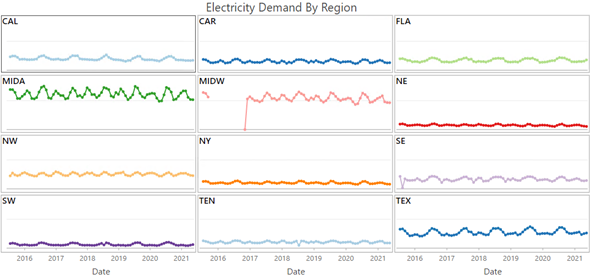
Axes
The options described in the subsections below control the axes and related settings.
Y-axis bounds
Default minimum and maximum y-axis bounds are based on the range of data values represented on the axis. You can customize these values by providing a new axis bound value. Clicking the reset button will revert the axis bound to the default value. Setting axis bounds can be used as a way to keep the scale of a chart consistent for comparison.
Log axis
By default, line chart axes are displayed on a linear scale. Numeric (nondate) axes can be displayed on a logarithmic scale by checking the Log axis check box on the Axes tab in the Chart Properties pane.
Logarithmic scales are useful when visualizing data with a large positive skew in which the majority of data points have a small value, with a few data points with very large values. Changing the scale of the axis does not change the value of the data, only the way it is displayed.
Linear scales are based on addition, and logarithmic scales are based on multiplication.
On a linear scale, each increment on the axis represents the same distance in value. For example, in the axis diagram below, each increment on the axis increases by adding 10.

On a logarithmic scale, increments increase by magnitudes. In the axis diagram below, each increment on the axis increases by multiplying by 10.

Note:
Logarithmic scales cannot display negative values or zero. If you log the axis of a variable with negative values or zero, those values will not appear on the chart.
Adaptive axis bounds
When a multiseries line chart is displayed with the Grid option, the axis bounds can be configured with the following options:
- Fixed—Applies the global minimum and maximum bounds to all minicharts.
- Adaptive—Adjusts to the local minimum and maximum bounds for each minichart.
Grid intervals
Configure grid intervals for the y-axis using the Interval control. The default grid interval will be calculated automatically.
Invert axis
The y-axis of a line chart can be inverted by checking the Invert axis check box.
Number format
You can format the way an axis displays numeric values by specifying a number format category or defining a custom format string. For example, $#,### can be used as a custom format string to display currency values.
Appearance
The options described in the subsections below control the chart appearance and related settings.
Titles and description
The charts and axes default titles are based on the variable names and chart type. These can be edited on the General tab in the Chart Properties pane. You can also provide a value for the Description option, which is a block of text that appears at the bottom of the chart window.
Series style
Series style can be configured on the Series tab in the Chart Properties pane by clicking the Symbol color patch in the Series table. Use the pop-up to configure the style, size, color, and transparency for line and point symbols. To apply a common style to multiple series, select multiple rows in the Series table, and click the Symbol color patch for one of the selected series. Alternatively, use the Color scheme drop-down list on the Series tab to apply a palette to the series in a chart.
Data labels
Labels displaying the value of each data point can be turned on by checking Label lines on the Data tab in the Chart Properties pane. Additional series-level style options can be configured on the Series tab by clicking the text patch in the Data Labels column of the Series table.
Orientation
Lines can be drawn vertically by clicking the Rotate chart button  in the chart window.
in the chart window.
Guides
Guide lines or ranges can be added to charts as a reference or way to highlight significant values. To add a new guide, go to the Guides tab in the Chart Properties pane, and choose whether you want to draw a vertical or horizontal guide. Click the arrow on the Add guide button, and select one of the following options:
- Create fixed value line or range guide—Draw a line or range guide at a fixed location. When this option is selected, provide a value for Value where you want the line to draw. To create a range, provide a to value.
- Create data-driven guide—Draw a data-driven guide. When this option is selected, use the Value drop-down list to select a field whose values will be used to calculate the location of the guide. Select an aggregation option to specify how these values are summarized.
- Create point or polyline guide—Draw a point or polyline guide. When this option is selected, edit the data table to input x- and y-values that will create the vertices to determine how the guide line is drawn. Enter one vertex to create a point guide. This option is only available when both axes are continuous.
Example
Create a line chart to visualize trends in fire events in Naperville from 2007 through 2010 using the following settings:
- Date or Number—Date
- Aggregation—Count
- Time Interval Size—3 months
- Split by—Time of day
